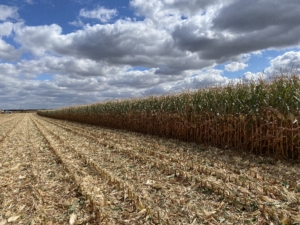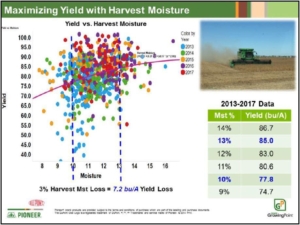Agronomic/Harvest Update – September 29, 2020….Things to think about and watch for….

Topics:
- Growing Degree Day Update
- Harvest Weather Update
- Harvest update…things to think about and watch for….
As of September 28th, we have accumulated approximately the following for Growing Degree Days in 2020:
Planting Date GDD’s2020 Average GDD Departure from average
April 21 2938 2729 +209 (+14 days)
April 26 2885 2690 +195 (+13 days)
May 1 2834 2655 +179 (+12 days)
The month of September has continued to see the 2020 growing season to be ahead of average on GDUs. In fact, there has been a net gain of 3 days over the last two weeks.
Harvest Weather Update




The above maps show the 6-10 temp/precip and 8-14 day temp/precip forecast maps. Temps over the next week will be cooler than average. After this period it looks like there will be a warmer than average spell. Overall precip forecast over the next two weeks continues to be dry. This should allow for good harvest conditions, however, drydown on irrigated corn will continue to be somewhat slow overall due to the cool temps next week. Our season’s first frost is predicted for this upcoming Friday morning. A frost/freeze should not hurt much of anything at this stage – unless corn was planted late-May or after – as most all fields are black-layered, or close to it.
Soybean Harvest Update….things to think about and watch for….
So far soybean harvest has been progressing right along, with yields coming in very good to excellent…..many ‘best ever’ whole field averages in the area….even dryland yields have been better than expected. Some things to keep in mind as soybean harvest progresses:
- There is an average yield reduction of 7-8% when going from 13% moisture to 8% moisture soybeans. This means an average loss of 6 bushels/acre (using an 80 bu yield) just in moisture, along with potential reduction from header loss, etc. Many soybean fields are now in the 9-10% moisture range, and given the above forecast maps, they will continue to dry quickly, especially the early group maturities. The below chart shows the average yield lost from lower harvest moisture and delayed harvest over five year on-farm study from Pioneer.

- So far seeing minimal impact from white mold….SDS is around but limited to certain fields. The increased solar radiation over the past two months along with ‘drier’ overall soil moisture profiles (ie. drainage) under irrigated fields versus past years, are two key factors in the excellent soybean yields that we are seeing.
- Water was still a key factor….those areas that saw a little more rainfall than others have a tick better overall yields as well.
- Keep in mind that this year saw the ‘earliest ever’ overall planting dates for soybeans as well….
Corn Harvest Update….things to think about and watch for….
Corn harvest has so far been pretty limited….a little wet corn and dryland coming out. Much of the irrigated is ranging from 24-34% in grain moisture, with some fields still not black-layered as this is being written. Grain moistures on dryland are now starting to come down…seeing 14-20% moistures now. Too early to tell yield trends yet. We are definitely getting an extended grain-fill period which should be good for yield and standability! Some things to keep in mind as corn harvest progresses:
- Grain moisture drydown is dependent upon temperature and ear husk structure. On average, it takes 15-20 GDU’s to lower grain moisture each point from 30% down to 25%, 20-25 GDU’s per point of moisture from 25% to 22% and 25-30 GDU’s per point from 22% to 20%. A high of 75 degrees and a low of 55 degrees equate to 15 GDU’s, which should roughly take a point of moisture out per day when grain moisture’s are 25%+. So temps in the mid-70’s for highs and mid-50’s for lows should take corn from 30% to 25% in a week’s time. We will need to see some warmer temps later in October to get moisture’s into the upper teens and low-20’s. So, taking into consideration the above forecast maps, grain moisture drydown on irrigated looks to be pretty limited over the next week to 10 days yet….a frost/freeze will likely speed this process up however.
- Sunlight. Overall sunlight for the past 60 days has been 8% above normal…it was over 10%+ above in August and slightly below average in September. For some perspective, sunlight was down 30+% from average during those days in which smoke from the fires out west was present in our atmosphere. Just like in soybeans however, the overall increase in sunlight is having a positive effect in corn. Couple this increase in sunlight with an extended grain-fill, and we should expect very good test weights and grain quality (deep grain color).
- Test weights from the wet corn that has been harvested so far are very good. Average test weights are in the 54-56# range at 25-32% moisture. This equates to 60+# test weight at 15% moisture. Expect to see improved grain quality (denser kernel) versus past years as well….should lead to easier and longer grain storage. A denser kernel also means longer grain moisture drydown.
- Harvest Priority…I am seeing plant health deteriorate over this past week in many fields in the area, especially those fields that experienced the July storms. Late-season plant health will become more of an issue as harvest gets delayed, especially if we continue to see cooler than normal temps slowing grain drydown. Late Southern Rust infestations have also taken over spots in some fields….shutting down plants earlier than normal; may not affect yield but will impact stalk quality. Don’t just assume the fields are ‘okay’. Also, how well the fields were watered up late will be a key to overall plant health, even more so maybe than fungicide applications. Seeing this is area fields already, especially in storm related areas….having made that ‘last’ circle will help staygreen and stalk quality. Keep an eye on those fields that lose color rapidly, or that have ears fall over in a quick time frame, as these would be indicators of possible poor stalk quality, and would need to come out first. As of now, I am thinking overall late-season stalks will not be as good as the past few years….too much stress tends to lead to poor late-season plant health.
- Dryland. As mentioned above, much of the dryland crop is testing 14-20% in grain moisture. Dryland acres should be coming out anytime. Keep an eye on dryland corners. If dryland sits ‘to long’, there is a potential for ear slip due to the ear shank shrinking and drying out due to drought conditions and premature plant shutdown. I don’t expect to see much of this, but it is possible if dryland corners are still standing 3-4 weeks from now.
Alfalfa and newly seeded rye….if the current dry conditions persist into October, much of the newly-seeded rye will need more irrigation to keep it coming. Alfalfa needs adequate moisture to improve winter hardiness….keep this in mind as we head into late fall-early winter. If the winter is colder than normal and more open, a good soil moisture profile will be important to helping the alfalfa survive any potential winterkill.
As always, please call with any questions, comments, or concerns. Have a safe and successful harvest!!
Starman Seed Service, Inc.

